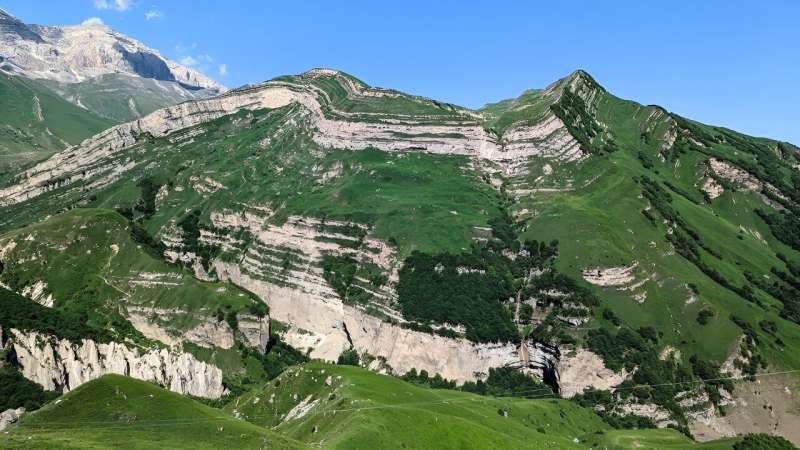This article has been reviewed according to Science X's editorial process and policies. Editors have highlighted the following attributes while ensuring the content's credibility:
fact-checked
trusted source
proofread
Uncovering earthquake evidence in Azerbaijan's greater Caucasus mountains

The Greater Caucasus mountain range stretches between the Black and Caspian Seas across parts of Russia, Georgia, and Azerbaijan. These formidable peaks are the result of the subduction of the Arabian plate beneath the Eurasian plate.
The energy stored by the tectonic forces that push these two plates together is released during earthquakes, uplifting the Greater Caucasus mountains. These tectonic movements have mostly been accommodated by the Kura fold-thrust belt, which runs for approximately 275 kilometers along the southern front of the mountain range between Tbilisi, Georgia, and Shamakhi, Azerbaijan.
Large, destructive earthquakes in central Azerbaijan are described in historical records, including two in 1668 and 1902. Aside from these two examples, scientists don't know much about other past earthquakes that may have ruptured along this major plate boundary fault system.
A new study by Ian Pierce and colleagues offers the first insights into the earthquake record for this region, as well as a warning. Using elevation models produced from satellite and drone images, the researchers identified evidence of not only long-term tectonic deformation but also geologically recent earthquakes in the landscape.
By digging two paleoseismic trenches and using radiocarbon dating on the sedimentary layers below the surface, researchers identified several past seismic events and learned more about the fault's potential for future large earthquakes.
In the first paleoseismic trench, radiocarbon dating of sediment revealed evidence of two major earthquakes, one occurring between 1713 and 1895 and the other occurring sometime between 1872 and 2003. They could correlate to the known quakes in 1668 and 1902.
Information gathered at the trench led the scientists to suggest that the 1902 earthquake may have had a magnitude of up to 7.4, rather than 6.9, as previously believed. The second trench, 60 kilometers to the west, held evidence of at least one surface-rupturing earthquake having occurred between 334 and 118 BCE and possibly another that happened in the past 2,000 years.
In contrast, farther west along the Kura fold-thrust belt, there are no reported historical ruptures from the past four to eight centuries. The scientists suggest that ruptures in this portion of the fault belt may be more infrequent but more destructive and that they may have built up sufficient strain to produce an earthquake of magnitude ~7.7 or above.
They also note that further field research is needed to confirm their results, to better estimate the magnitude and length of these ruptures, and to learn more about the histories of other faults within the belt.
More information: Ian Pierce et al, Surface Rupturing Earthquakes of the Greater Caucasus Frontal Thrusts, Azerbaijan, Tectonics (2024). DOI: 10.1029/2023TC007758
Provided by American Geophysical Union
This story is republished courtesy of Eos, hosted by the American Geophysical Union. Read the original story here.




















